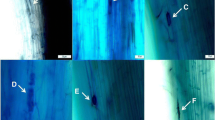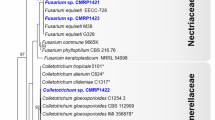Abstract
Phyllospheric bacteria were isolated from microsites around essential-oil-containing glands of two oregano (Origanum vulgare subsp. hirtum) lines. These bacteria, 20 isolates in total, were subjected to bioassays to examine their growth potential in the presence of essential oils at different concentrations. Although there were qualitative and quantitative differences in the essential oil composition between the two oregano lines, no differences were recorded in their antibacterial activity. In disk diffusion bioassays, four of the isolated strains could grow almost unrestrained in the presence of oregano oil, another five proved very sensitive, and the remaining 11 showed intermediate sensitivity. The strain least inhibited by oregano essential oil was further identified by complete16s rRNA gene sequencing as Pseudomonas putida. It was capable of forming biofilms even in the presence of oregano oil at high concentrations. Resistance of P. putida to oregano oil was further elaborated by microwell dilution bioassays, and its topology on oregano leaves was studied by electron microscopy. When inoculated on intact oregano plants, P. putida was able not only to colonize sites adjacent to essential oil-containing glands, but even to grow intracellularly. This is the first time that such prolific bacterial growth inside the glands has been visually observed. Results of this study further revealed that several bacteria can be established on oregano leaves, suggesting that these bacteria have attributes that allow them to tolerate or benefit from oregano secondary metabolites.




Similar content being viewed by others
References
Andersen, G. L., Menkissoglu, O., and Lindow, S. E. 1991. Occurrence and properties of copper-tolerant strains of Pseudomonas syringae isolated from fruit trees in California. Phytopathology 81:648–656.
Andrews, J. H. 1996. Phyllosphere ecology: past, present and future, pp. 285–294, in C. E. Morris, P. C. Nicot, and C. Nguyen (eds.), Aerial Plant Surface Microbiology. Plenum, New York.
Baldotto, L. and Olivares, F. 2008. Phylloepiphytic interaction between bacteria and different plant species in a tropical agricultural system. Can. J. Microbiol. 54:918–931.
Beattie, G. A. 2007. Plant associated bacteria: survey, molecular phylogeny, genomics and recent advances, pp. 1–56, in S. S. Gnanamanickan (ed.), Plant associated bacteria. Springer, Dordrecht.
Bednarek, P. and Osbourn, A. 2009. Plant–microbe interactions: Chemical diversity in plant defense. Science 324:746–748.
Bozabalidis, A. M. 2002. Structural features of Origanum sp, pp. 11–64, in S. E. Kintzios (ed.), Oregano. The genera Origanum and Lippia. Taylor & Francis, London.
Cristani, M., Arrigo, M., Mandalari, G., Castelli, F., Sarpietro, M. G., and Micieli, D. 2007. Interaction of four monoterpenes contained in essential oils with model membranes: Implications for their antibacterial activity. J. Agric. Food Chem. 55:6300–6308.
Duke, S. O., Canel, C., Rimando, A. M., Tellez, M. R., Duke, M. V., and Paul, R. N. 2000. Current and potential exploitation of plant glandular trichome productivity. Adv. Bot. Res. 31:121–141.
Eguchi, Y., Curtis, O. F., and Shetty, K. 1996. Interaction of hyperhydricity-preventing Pseudomonassp. with oregano (Origanum vulgare) and selection of high rosmarinic acid-producing clonal lines. Food Biotechnol. 10:191–202.
Hallahan, D. L. 2000. Monoterpenoid biosynthesis in glandular trichomes of Labiate plants. Adv. Bot. Res. 31:77–111.
Hirano, S. S. and Upper, C. D. 1989. Diel variation in population size and ice nucleation activity of Pseudomonas syringae on snap bean leaflets. Appl. Environ. Microbiol. 55:623–630.
Hunter, P. J., Hand, P., Pink, D., Whipps, J. M., and Bending, G. D. 2010. Both leaf properties and microbe–microbe interactions influence within-species variation in bacterial population diversity and structure in the Lettuce (Lactuca Species) phyllosphere. Appl. Environ. Microbiol. 76:8117–8125.
Kadoglidou, K., Lagopodi, A., Karamanoli, K., Vokou, D., Bardas, G. A., Menexes, G., and Constantinidou, H.-I. A. 2011. Inhibitory and stimulatory effects of essential oils and individual monoterpenoids on growth and sporulation of four soil-borne fungal isolates of Aspergillus terreus, Fusarium oxysporum, Penicillium expansum, and Verticillium dahlia. Eur. J. Plant Pathol. 130:297–309.
Karamanoli, K., Menkissoglu-Spiroudi, U., Vokou, D., and Constantinidou, H.-I. A. 2000. Bacterial colonization of the phyllosphere of the phyllosphere of Mediterranean aromatic plants. J. Chem. Ecol. 26:2035–2048.
Karamanoli, K., Menkissoglu-Spiroudi, U., Bosabalidis, A. M., Vokou, D., and Constantinidou, H.-I. A. 2005. Bacterial colonization of the phyllosphere of nineteen plant species and antimicrobial activity of their leaf secondary metabolites against leaf associated bacteria. Chemoecology 15:59–67.
Karpouzas, D. G., Ntougias, S., Iskidou, E., Rousidou, C., Papadopoulou, K. K., Zervakis, G., and Ehaliotis, C. 2010. Olive mill wastewater affects the structure of soil bacterial communities. Appl. Soil Ecol. 45:101–111.
Kubo, I., Muroi, H., and Himejima, M. 1992. Antimicrobial activity of green tea flavor components and their combination effects. J. Agric. Food Chem. 40:245–248.
Leben, C. 1988. Relative humidity and the survival of epiphytic bacteria with buds and leaves of cucumber plants. Phytopathology 78:179–185.
Leveau, J. 2006. Microbial communities in the phyllosphere, pp. 334–367, in M. Riederer and C. Muller (eds.), Biology of the plant cuticle. Annual plant reviews Vol. 23. Blackwell, Oxford.
Lindow, S. E. and Brandl, M. T. 2003. Microbiology of the phyllosphere. Appl. Environ. Microbiol. 69:1875–1883.
Loh, K. C. and Cao, B. 2008. Paradigm of biodegradation using Pseudomonas putida—A review of proteomics studies. Enzyme Microb. Technol. 43:1–12.
Macfaddin, J. F. 1980. pp. 51–54, Biochemical tests for identification of medical bacteria. Williams and Wilkins, Baltimore.
Mah, T. F. and O’Toole, G. A. 2001. Mechanisms of biofilm resistance to antimicrobial agents. Trends Microbiol. 9:34–39.
McDowell, E. T., Kapteyn, J., Schmidt, A., Li, C., Kang, J. H., Descour, A., Shi, F., Larson, M., Schilmiller, A. A., An, L., Jones, A. D., Pichersky, E., Soderlund, C. A., and Gang, D. R. 2011. Comparative functionally genomic analysis of Solanum glandular trichome types 1 [W] [OA]. Plant Physiol. 155:524–539.
Monier, J. M. and Lindow, S. E. 2004. Frequency, size and localization of bacterial aggregates on bean leaf surfaces. Appl. Environ. Microbiol. 70:346–355.
Nakhamchik, A., Wilde, C., and Rowe-Magnus, D. A. 2008. Cyclic-di-GMP regulates extracellular polysaccharide production, biofilm formation and rugose colony development by Vibrio vulnificus. Appl. Environ. Microbiol. 74:4199–4209.
Sambrook, J., Fritsch, E. F., and Maniatis, T. 1989. Molecular cloning: a laboratory manual, 2nd ed. Cold Spring Harbor, New York.
Shepherd, R. W., Bass, W. T., Houtz, R. L., and Wagner, G. J. 2005. Phylloplanins of tobacco are defensive proteins deployed on aerial surfaces by short glandular trichomes. Plant Cell 17:1851–1861.
Shetty, K., Curtis, O. F., and Levin, R. E. 1996. Specific interaction of mucoid strains of Pseudomonas spp. with oregano (Origanum vulgare) clones and the relationship to prevention of hyperhydricity in tissue culture. J. Plant Physiol. 149:605–611.
Steel, K. J. 1961. The oxidase reaction as a toxic tool. J. Gen. Microbiol. 25:297–306.
Sundin, G. W. and Jacobs, J. L. 1999. Ultraviolet radiation (UVR) sensitivity analysis and UVR survival strategies of a bacterial community from the phyllosphere of field-grown peanut (Arachis hypogeae L.). Microb. Ecol. 38:27–38.
Surico, G. 1993. Scanning electron microscopy of olive and oleander leaves colonized by Pseudomonas syringae subsp. savastanoi. J. Phytopathol. 138:31–40.
Timmis, K. N. 2002. Pseudomonas putida: a cosmopolitan opportunist par excellence. Environ. Microbiol. 4:779–781.
Ultee, A., Slump, R. A., Steging, G., and Smid, E. J. 2000. Antimicrobial activity of carvacrol on rice. J. Food Prot. 63:620–624.
Ultee, A., Bennik, M. H. J., and Moezelaar, R. 2002. The phenolyc hydroxyl group of carvacrol is essential for action against the food-borne pathogen Bacillus cereus. Appl. Environ. Microbiol. 68:1561–1568.
Vincent, J. M. 1970. A manual for the practical study of root-nodule bacteria. Blackwell, Oxford.
Vokou, D. 2007. Allelochemicals, allelopathy and essential oils: a field in search of definitions and structure. Allelopathy J. 19:119–135.
Vokou, D., Kokkini, S., and Bessiere, J.-M. 1993. Geographic variation of Greek oregano (Origanum vulgare ssp. hirtum) essential oils. Biochem. Syst. Ecol. 21:287–295.
Vokou, D., Chalkos, D., Yangou, M., and Karamanlidou, G. 2002. Activation of soil respiration and shift of the microbial population balance in soil as a response to Lavandula stoechas essential oil. J. Chem. Ecol. 28:755–768.
Vokou, D., Vareli, K., Zarali, E., Karamanoli, K., Constantinidou, H.-I. A., Monokrousos, N., Halley, J. M., and Sainis, I. In press. Exploring biodiversity in the bacterial community of the Mediterranean phyllosphere and its relationship with airborne bacteria. Microb. Ecol.
Wagner, G. J., Wang, E., and Shepherd, R. W. 2004. New approaches for studying and exploiting an old protuberance, the plant trichomes. Ann. Bot. 93:3–11.
Warner, J. C., Rothwell, S. D., and Keevil, C. W. 2008. Use of episcopic differential interference contrast microscopy to identify bacterial biofilms on salad leaves and track colonization by Salmonella Thompson. Environ. Microbiol. 10:918–925.
Yadav, R. K. P., Halley, J. M., Karamanoli, K., Vokou, D., and Constantinidou, H.-I. A. 2004. Bacterial populations on the leaves of Mediterranean plants: Quantitative features and testing of distribution models. Environ. Exp. Bot. 52:63–77.
Yadav, R. K. P., Karamanoli, K., and Vokou, D. 2005. Bacterial colonization of the phyllosphere of Mediterranean perennial species as influenced by structural and chemical leaf features. Microb. Ecol. 50:185–196.
Yadav, R. K. P., Papatheodorou, E. M., Karamanoli, K., Constantinidou, H.-I. A., and Vokou, D. 2008. Abundance and diversity of the phyllosphere bacterial communities of Mediterranean perennial plants that differ in leaf chemistry. Chemoecology 18:217–226.
Yadav, R. K. P., Karamanoli, K., and Vokou, D. 2010. Estimating bacterial population on the phyllosphere by serial dilution plating and leaf imprint methods. Ecoprint 17:47–52.
Author information
Authors and Affiliations
Corresponding author
Rights and permissions
About this article
Cite this article
Karamanoli, K., Thalassinos, G., Karpouzas, D. et al. Are Leaf Glandular Trichomes of Oregano Hospitable Habitats for Bacterial Growth?. J Chem Ecol 38, 476–485 (2012). https://doi.org/10.1007/s10886-012-0117-7
Received:
Revised:
Accepted:
Published:
Issue Date:
DOI: https://doi.org/10.1007/s10886-012-0117-7




